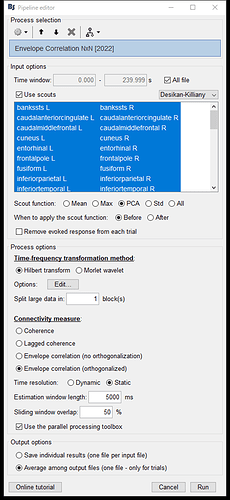Dear All,
We want to calculate the functional connectivity (at the source level) from resting-state MEG recordings using envelope correlation / Hilbert transform.
At the moment, it's basically running the analysis for the entire 240 seconds, as shown in the screenshot below.
However data that is invalid for a certain period of time (such as 55 to 58 seconds) due to artifact removal processing cannot be analyzed normally.
We would like to ask for your opinion on the appropriate method and approach to deal with this situation.
(1) As a basic idea to do the analysis, what is the advantage of overlapping time windows when doing a growing correlation analysis at rest?
(2) Which strategy is more desirable: adopting a shorter epoch length (e.g., 5 seconds) to include the majority of the original data (235s) without increasing the number of analysis results through overlap, or determining the epoch length (e.g., 600 ms * 3 epochs for inclusion, and 600 ms * 1 epoch for exclusion) to maximize the increase in analysis results with a 50% overlap strategy?
Thanks in advance.
Best regards,
Tatsuhiko
